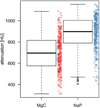Intra-individual comparison of magnesium citrate and sodium phosphate for bowel preparation at CT colonography: automated volumetric analysis of residual fluid for quality assessment
- PMID: 25239789
- PMCID: PMC4201391
- DOI: 10.1016/j.crad.2014.08.001
Intra-individual comparison of magnesium citrate and sodium phosphate for bowel preparation at CT colonography: automated volumetric analysis of residual fluid for quality assessment
Abstract
Aim: To perform an objective, intra-individual comparison of residual colonic fluid volume and attenuation associated with the current front-line laxative magnesium citrate (MgC) versus the former front-line laxative sodium phosphate (NaP) at CT colonography (CTC).
Materials and methods: This retrospective Health Insurance and Portability and Accountability Act-compliant study had institutional review board approval; informed consent was waived. The study cohort included 250 asymptomatic adults (mean age at index 56.1 years; 124 male/126 female) who underwent CTC screening twice over a 5 year interval. Colon catharsis at initial and follow-up screening employed single-dose NaP and double-dose MgC, respectively, allowing for intra-patient comparison. Automated volumetric analysis of residual colonic fluid volume and attenuation was performed on all 500 CTC studies. Colonic fluid volume <200 ml and mean attenuation between 300-900 HU were considered optimal. Paired t-test and McNemar's test were used to compare differences.
Results: Residual fluid volumes <200 ml were recorded in 192 examinations (76.8%) following MgC and in 204 examinations (81.6%) following NaP (p = 0.23). The mean total residual fluid volume was 155 ± 114 ml for MgC and 143 ± 100 ml for NaP (p = 0.01). The attenuation range of 300-900 HU was significantly more frequent for MgC (n = 220, 88%) than for NaP (n = 127, 50.8%; p < 0.001). Mean fluid attenuation was significantly lower for MgC (700 ± 165 HU) than for NaP (878 ± 155 HU; p < 0.001). Concomitant presence of both optimal fluid volume and attenuation was significantly more frequent for MgC 65.2% than for NaP (38%; p < 0.001).
Conclusions: Objective intra-individual comparison using automated volumetric analysis suggests that the replacement of NaP by MgC as the front-line laxative for CTC has not compromised overall examination quality.
Copyright © 2014 The Royal College of Radiologists. Published by Elsevier Ltd. All rights reserved.
Figures




References
-
- Kim DH, Pickhardt PJ, Taylor AJ, et al. CT colonography versus colonoscopy for the detection of advanced neoplasia. N Engl J Med. 2007;357:1403–1412. - PubMed
-
- Pickhardt PJ, Hassan C, Laghi A, Zullo A, Kim DH, Morini S. Cost-effectiveness of colorectal cancer screening with computed tomography colonography — the impact of not reporting diminutive lesions. Cancer. 2007;109:2213–2221. - PubMed
-
- Hassan C, Pickhardt P, Laghi A, et al. Computed tomographic colonography to screen for colorectal cancer, extracolonic cancer, and aortic aneurysm. Arch Intern Med. 2008;168:696–705. - PubMed
-
- Pickhardt PJ, Choi JR, Hwang I, et al. Computed tomographic virtual colonoscopy to screen for colorectal neoplasia in asymptomatic adults. N Engl J Med. 2003;349:2191–2200. - PubMed
Publication types
MeSH terms
Substances
Grants and funding
LinkOut - more resources
Full Text Sources
Other Literature Sources
Research Materials

